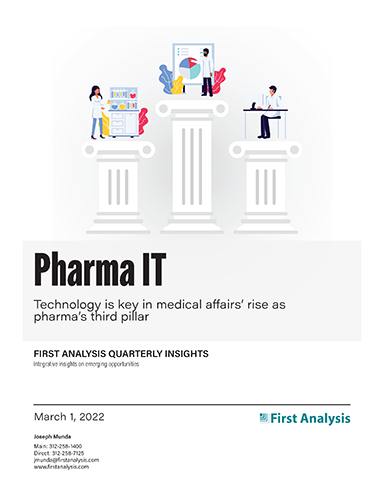Quarterly insights: Pharma IT
Technology is key in medical affairs’ rise as pharma’s third pillar

The pharmaceutical industry’s shift away from dependence on sales reps for commercialization, the broad evolution of healthcare in recent decades, and the effects of the pandemic on healthcare practices have set the stage for pharma companies’ medical affairs (MA) function to join commercialization and research and development as a key pillar of the industry. MA addresses the need to inform, sitting at a pivotal intersection in pharma and serving as an internal bridge between research and development and commercialization as well as a bridge between pharma companies and their external stakeholders.
Technology has been a key factor behind MA’s emergence as pharma’s third pillar. Digital tools have enabled MA to derive and communicate meaningful insights and evidence from the huge and complex mass of scientific data generated by the healthcare system. These tools continue to evolve, further empowering MA and making it even more effective as one of the three pillars.
We discuss three areas where innovative technology companies are delivering powerful new tools for MA personnel: finding key opinion leaders, engaging and collaborating virtually, and generating insights and evidence. For each, we highlight some of the technology providers that offer compelling solutions.
TABLE OF CONTENTS
Includes discussion of six private companies
- A brief history of medical affairs
- Technology among several factors making MA the third pillar
- Finding key opinion leaders
- Virtual engagement and collaboration
- Insights and evidence generation
- Powerful technologies strengthen pharma’s third pillar
- eClinical index lead over S&P 500 narrows; commercialization index turns negative
- Pharma IT M&A pace remains strong
- Pharma IT private placement pace accelerates from Q3 low
A brief history of medical affairs
Medical affairs got its start as a key pharma function in 1967 at Upjohn (now part of Viatris, VTRS). The increasing complexity of drugs led the company to rethink how it engaged and communicated with healthcare providers. It launched a technically sophisticated team of field personnel to work with sales representatives to improve the image of the company in the eyes of both clinical researchers and key opinion leaders. These medical science liaisons (MSLs), as they are known, employed a face-to-face strategy rooted in education to better understand the needs of Upjohn’s customers and leverage the insights gleaned to enhance the company’s product development strategy. With time and broad adoption throughout the industry, the model evolved into the medical affairs team – a team of scientifically and medically trained personnel who are experts in communicating complex therapeutic scientific and medical information to a variety of stakeholders.

Request full report
To access the full report, please provide your contact information in the form below. Thank you for your interest in First Analysis research.
